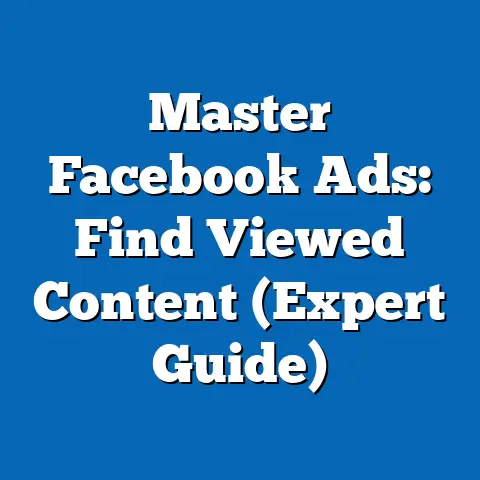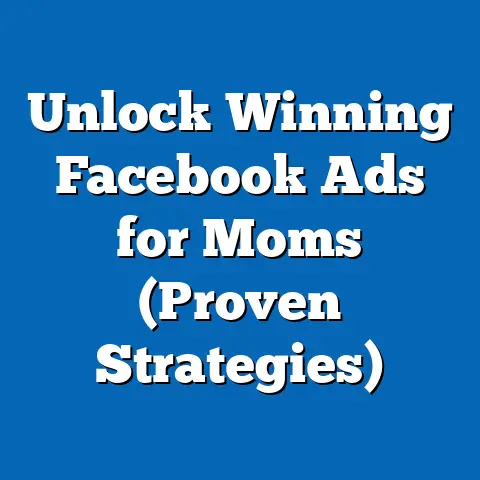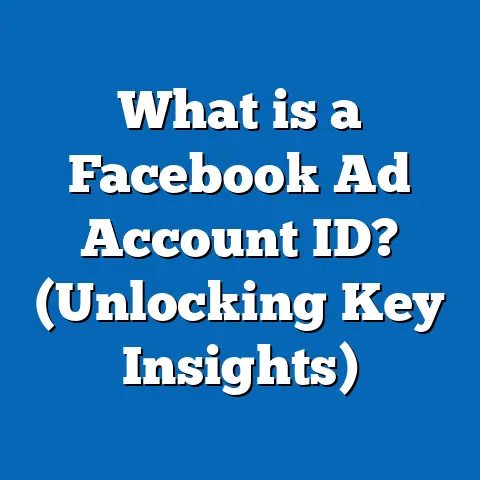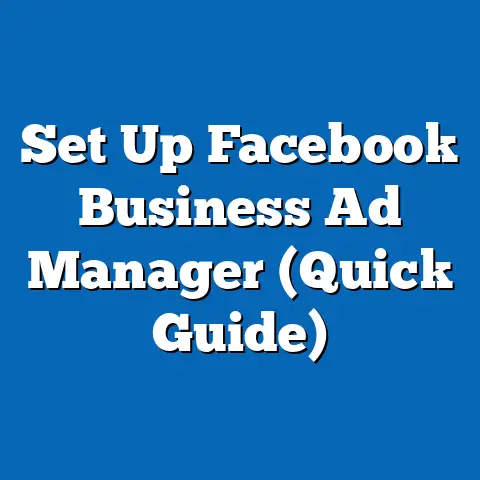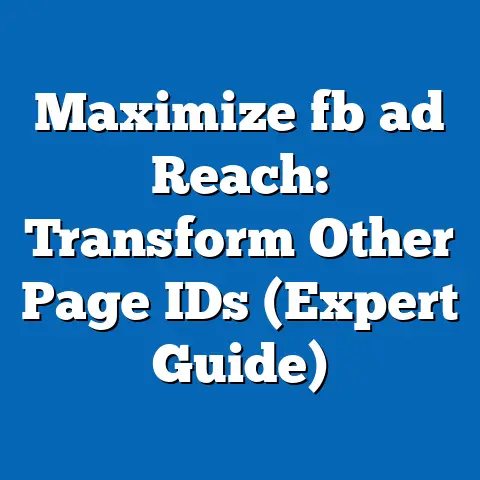Unlock Success with Special fb ad Categories (Pro Secrets)
Accessibility. It’s a word we hear a lot these days, but what does it really mean in the context of Facebook advertising? And more importantly, why should you, as a business owner or marketer, care? I’ve seen firsthand how prioritizing accessibility can transform a good campaign into a great one, not just by reaching a wider audience, but by building genuine connections and fostering brand loyalty.
Think of it this way: every potential customer deserves to feel seen and understood. When your ads are accessible, you’re sending a powerful message that you value inclusivity and diversity. This isn’t just about ticking boxes or complying with regulations; it’s about creating a more equitable and effective advertising landscape. In this guide, I’m going to dive deep into the world of special Facebook ad categories, revealing pro secrets that will not only help you navigate these categories effectively but also unlock a whole new level of engagement and conversion.
1. Introduction: The Power of Accessible Facebook Advertising
Accessibility in digital marketing goes beyond simply making your website compliant with web accessibility guidelines. It’s about ensuring that your message, your brand, and your products are available and understandable to everyone, regardless of their abilities or circumstances. In the realm of Facebook advertising, this means creating ads that are visually clear, aurally comprehensible, and cognitively easy to process.
Why is this so crucial? Because your audience is diverse. It includes people with visual impairments, hearing loss, cognitive disabilities, and those who speak different languages. Ignoring accessibility means excluding a significant portion of your potential customer base. It also means missing out on the opportunity to build a stronger, more inclusive brand that resonates with a wider audience.
Furthermore, accessibility aligns with Facebook’s own values and policies. The platform is committed to creating a fair and equitable advertising environment, and that’s where special ad categories come into play. These categories, which I’ll delve into in more detail, are designed to prevent discriminatory practices and promote equal opportunities. Understanding and leveraging these categories effectively is not just about compliance; it’s about unlocking the full potential of your Facebook advertising.
Think of it as building a house. You wouldn’t build a house without considering the needs of the people who will live in it. Similarly, you shouldn’t create an ad campaign without considering the needs of your entire target audience.
2. Understanding Facebook Ad Categories
Facebook ad categories are special classifications that apply to ads related to housing, employment, and credit. These categories were introduced to combat discriminatory advertising practices and ensure fair access to opportunities for all users.
What are the Categories?
- Housing: This category covers ads that offer or relate to housing, including rentals, real estate sales, and property management services.
- Employment: This category includes ads for job opportunities, internships, volunteer positions, and career-related services.
- Credit: This category encompasses ads for credit cards, loans, and other financial products or services.
Why Did Facebook Create These Categories?
Before these categories existed, advertisers could potentially target or exclude specific demographic groups based on protected characteristics like race, ethnicity, religion, and gender. This led to discriminatory practices, such as showing housing ads only to certain racial groups or excluding women from job opportunities.
To address these issues, Facebook implemented these special ad categories, which impose restrictions on targeting options. For example, advertisers in these categories cannot target based on age, gender, zip code (beyond a 15-mile radius), or exclude specific demographic groups. They also can’t use detailed targeting options that relate to protected characteristics.
Regulations and Impact on Targeting
The regulations associated with special ad categories significantly impact how you can target your ads. While these restrictions might seem limiting, they are designed to promote fairness and prevent discrimination. Here’s a breakdown of the key limitations:
- Limited Targeting Options: As mentioned, you cannot target based on age, gender, zip code (beyond a 15-mile radius), or exclude specific demographic groups.
- No Detailed Targeting Based on Protected Characteristics: You cannot use detailed targeting options that relate to protected characteristics, such as race, ethnicity, religion, or sexual orientation.
- Lookalike Audiences: Lookalike audiences can still be used, but they must be based on broad interests and demographics rather than specific protected characteristics.
My Experience: I remember when these categories were first introduced. There was definitely some initial frustration from advertisers who felt limited by the new restrictions. However, as time went on, it became clear that these categories not only promoted fairness but also forced advertisers to become more creative and strategic in their targeting. It pushed us to focus on the core value proposition of our products and services and to craft messaging that resonated with a broader audience.
Takeaway: Understanding the purpose and regulations of Facebook ad categories is crucial for creating ethical and effective campaigns. While the restrictions might require some adjustments to your targeting strategy, they ultimately contribute to a more inclusive and equitable advertising landscape.
3. The Importance of Accessibility in Facebook Ads
Accessibility in Facebook ads is more than just a nice-to-have; it’s a fundamental aspect of ethical and effective advertising. It encompasses visual, auditory, and cognitive accessibility, ensuring that your ads are usable and understandable by as many people as possible.
Principles of Accessible Advertising
- Visual Accessibility: This includes ensuring sufficient color contrast, using clear and readable fonts, and providing alternative text (alt text) for images. Alt text describes the content of an image for users who are visually impaired and rely on screen readers.
- Auditory Accessibility: This involves providing captions or transcripts for videos, ensuring that audio is clear and easy to understand, and avoiding background noise that can interfere with comprehension.
- Cognitive Accessibility: This focuses on making your ads easy to understand and process. This includes using clear and concise language, avoiding jargon or complex terminology, and organizing information in a logical and structured manner.
Improving User Experience and Engagement
Accessible ads can significantly improve user experience and engagement. When users can easily understand and interact with your ads, they are more likely to engage with your brand, click on your ads, and ultimately convert into customers.
- Increased Reach: By making your ads accessible, you can reach a wider audience, including people with disabilities who might otherwise be excluded.
- Improved Brand Perception: Prioritizing accessibility demonstrates that your brand values inclusivity and diversity, which can enhance your reputation and build customer loyalty.
- Higher Engagement Rates: Accessible ads are more likely to be noticed and understood, leading to higher click-through rates and conversion rates.
Statistics and Case Studies
The impact of accessibility on ad performance is well-documented. According to a study by the World Wide Web Consortium (W3C), websites with accessible content have a 20% higher conversion rate than those without. While this statistic focuses on websites, the same principles apply to Facebook ads.
I’ve personally seen campaigns where simply adding alt text to images resulted in a noticeable increase in engagement. It’s a small change that can make a big difference.
Takeaway: Accessibility is not just about compliance; it’s about creating a better experience for all users and improving the overall performance of your Facebook ads.
4. Pro Secrets for Utilizing Special Facebook Ad Categories
Now, let’s get into the real meat of the matter: how to leverage special Facebook ad categories to create effective and accessible campaigns. Here are some pro secrets that I’ve learned over the years:
4.1 Targeting Effectively
Targeting effectively within special ad categories requires a shift in mindset. You can’t rely on the same demographic targeting options that you might use for other campaigns. Instead, you need to focus on broader interests and behaviors that align with your target audience.
Identifying and Targeting Audiences
- Focus on Interests: Instead of targeting based on age or gender, focus on interests that are relevant to your product or service. For example, if you’re advertising housing, you could target people interested in “home improvement,” “real estate,” or “apartment living.”
- Leverage Behaviors: Facebook allows you to target users based on their behaviors, such as “first-time home buyers” or “people who recently moved.”
- Use Broad Geotargeting: Since you can’t target specific zip codes, use a broader geotargeting radius (at least 15 miles) around your target area.
- Custom Audiences: While you can’t upload lists of users with specific demographic characteristics, you can use custom audiences based on website visitors or existing customers. Just make sure your custom audience data doesn’t inadvertently include protected characteristics.
Creating Resonant Personas
Creating detailed personas is essential for understanding your target audience within special ad categories. A persona is a fictional representation of your ideal customer, based on research and data about your existing customers.
- Gather Data: Conduct surveys, interviews, and focus groups to gather data about your target audience’s needs, motivations, and pain points.
- Identify Common Traits: Look for common traits and patterns in your data. What are their interests? What are their challenges? What are their goals?
- Create Realistic Profiles: Develop detailed profiles for each persona, including their demographics (without violating Facebook’s restrictions), interests, behaviors, and motivations.
Example: Let’s say you’re advertising a job opportunity in the tech industry. You might create a persona named “Tech-Savvy Sarah,” who is interested in coding, software development, and career advancement. You could then target your ads to people who share these interests, regardless of their age or gender.
4.2 Crafting Compelling Copy
Writing compelling ad copy is crucial for engaging your target audience and driving conversions. However, within special ad categories, it’s even more important to be inclusive and avoid language that could be perceived as discriminatory.
Inclusive Language
- Avoid Gendered Language: Use gender-neutral terms whenever possible. For example, instead of saying “he” or “she,” use “they” or “the applicant.”
- Be Mindful of Cultural Sensitivity: Avoid language that could be offensive or insensitive to different cultures or ethnic groups.
- Focus on Benefits: Highlight the benefits of your product or service for all users, regardless of their background or circumstances.
Tone and Engagement
- Be Authentic: Be genuine and authentic in your messaging. People can spot insincerity a mile away.
- Use Storytelling: Tell stories that resonate with your target audience and create an emotional connection.
- Ask Questions: Engage your audience by asking questions that encourage them to think about their needs and motivations.
Example: Instead of saying “This apartment is perfect for young professionals,” you could say “This apartment offers a comfortable and convenient living space for anyone looking to be close to the city.”
4.3 Visual Elements
Visual elements play a critical role in capturing attention and conveying your message. However, within special ad categories, it’s important to ensure that your visuals are accessible to all users, including those with visual impairments.
Accessible Design Principles
- Color Contrast: Ensure that there is sufficient color contrast between your text and background. This makes it easier for people with low vision to read your ads.
- Text Size: Use a font size that is large enough to be easily readable on mobile devices.
- Alternative Text (Alt Text): Provide descriptive alt text for all images. This allows screen readers to convey the content of the image to users who are visually impaired.
- Avoid Flashing Animations: Flashing animations can trigger seizures in people with epilepsy.
Successful Examples
Look at ads that feature diverse groups of people and showcase a variety of lifestyles. Focus on images that are clear, well-lit, and visually appealing.
My Experience: I once worked on a campaign for a housing complex that featured images of happy residents from diverse backgrounds. We made sure to include alt text for all images and to use a color palette that was accessible to people with low vision. The campaign was incredibly successful, generating a high volume of leads and positive engagement.
4.4 Testing and Optimization
Testing and optimization are essential for maximizing the performance of your Facebook ads. Within special ad categories, it’s even more important to track your results and make adjustments based on data.
A/B Testing Methods
- Test Different Ad Copy: Experiment with different headlines, body text, and calls to action to see what resonates best with your target audience.
- Test Different Visuals: Try different images, videos, and graphics to see which ones capture the most attention.
- Test Different Targeting Options: Experiment with different interests, behaviors, and custom audiences to see which ones generate the best results.
Analyzing Performance Metrics
- Click-Through Rate (CTR): This measures the percentage of people who click on your ad after seeing it.
- Conversion Rate: This measures the percentage of people who take a desired action (e.g., filling out a form, making a purchase) after clicking on your ad.
- Cost Per Acquisition (CPA): This measures the cost of acquiring a new customer through your ad campaign.
Adjusting Campaigns
- Based on Data: Make adjustments to your campaigns based on the data you collect. If one ad copy is performing better than another, focus on that copy. If one targeting option is generating more leads, focus on that option.
- Continuously Monitor: Continuously monitor your campaigns and make adjustments as needed. The Facebook advertising landscape is constantly changing, so it’s important to stay on top of the latest trends and best practices.
Takeaway: Effective targeting, compelling copy, accessible visuals, and continuous testing and optimization are all essential for success within special Facebook ad categories.
5. Real-World Success Stories
Let’s take a look at some real-world examples of brands that have successfully utilized special Facebook ad categories to enhance their campaigns:
Case Study 1: A Housing Provider
A housing provider wanted to advertise their apartment rentals on Facebook. They used broad geotargeting, focusing on a 20-mile radius around their properties. They created compelling ad copy that highlighted the amenities and benefits of their apartments, and they used images of diverse residents enjoying their living spaces. They also made sure to include alt text for all images.
The results were impressive. The campaign generated a high volume of leads and positive engagement, and the housing provider was able to fill their vacancies quickly and efficiently.
Case Study 2: An Employment Agency
An employment agency wanted to advertise job opportunities on Facebook. They focused on targeting people interested in career advancement and specific industries. They created ad copy that was inclusive and avoided gendered language. They also used images of diverse employees in various roles.
The campaign was a success. The employment agency was able to attract a diverse pool of qualified candidates for their job openings.
Lessons Learned
- Focus on Value: Highlight the value proposition of your product or service for all users, regardless of their background or circumstances.
- Be Inclusive: Use inclusive language and visuals that resonate with a diverse audience.
- Test and Optimize: Continuously test and optimize your campaigns to improve performance.
6. Common Pitfalls and How to Avoid Them
Even with the best intentions, it’s easy to make mistakes when using special Facebook ad categories. Here are some common pitfalls to avoid:
- Accidental Discrimination: Avoid using language or visuals that could be perceived as discriminatory, even if unintentionally.
- Ignoring Accessibility: Don’t forget to prioritize accessibility in your ad design.
- Over-Targeting: Avoid targeting too narrowly, as this can limit your reach and potentially violate Facebook’s policies.
- Neglecting Testing: Don’t neglect to test and optimize your campaigns.
Continuous Learning
The Facebook advertising landscape is constantly evolving, so it’s important to stay informed about the latest trends and best practices. Follow industry blogs, attend webinars, and network with other marketers to stay ahead of the curve.
7. Future Trends in Facebook Advertising and Accessibility
The future of Facebook advertising is likely to be even more focused on accessibility and inclusivity. As technology advances, we can expect to see new tools and features that make it easier to create accessible ads and reach diverse audiences.
Emerging Technologies
- AI-Powered Accessibility Tools: AI-powered tools can automatically generate alt text for images, transcribe audio, and translate languages.
- Personalized Advertising: Personalized advertising can deliver ads that are tailored to each user’s individual needs and preferences.
- Virtual Reality (VR) and Augmented Reality (AR): VR and AR technologies can create immersive advertising experiences that are accessible to people with disabilities.
Staying Informed
Stay informed about changes in policies and best practices by following industry blogs, attending webinars, and networking with other marketers.
8. Conclusion
In conclusion, accessibility is not just a buzzword; it’s a fundamental aspect of ethical and effective Facebook advertising. By understanding and leveraging special ad categories, prioritizing accessibility in your ad design, and continuously testing and optimizing your campaigns, you can unlock a whole new level of engagement and conversion.
Remember, inclusive advertising is not just about meeting regulatory requirements; it’s about building a stronger, more inclusive brand that resonates with a wider audience. So, take the pro secrets I’ve shared in this guide and put them into action. I encourage you to experiment, learn, and adapt your strategies to create Facebook ad campaigns that are both effective and accessible. The future of advertising is inclusive, and by embracing accessibility, you can position your brand for long-term success. It’s not just the right thing to do; it’s the smart thing to do. Now, go out there and create some amazing, accessible ads!

